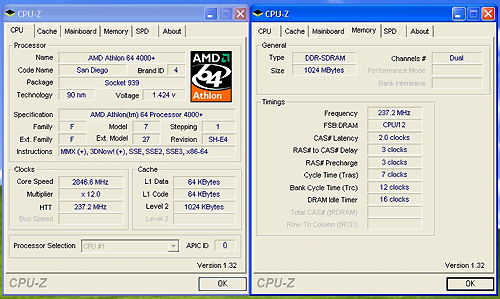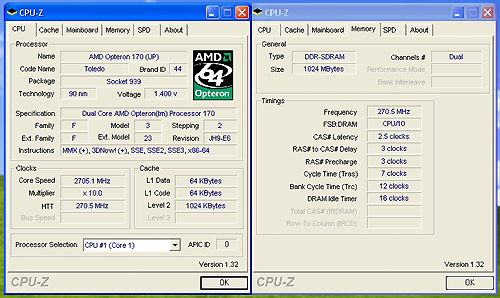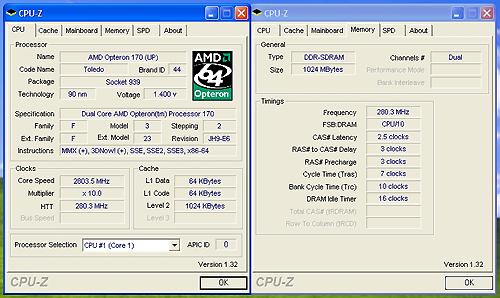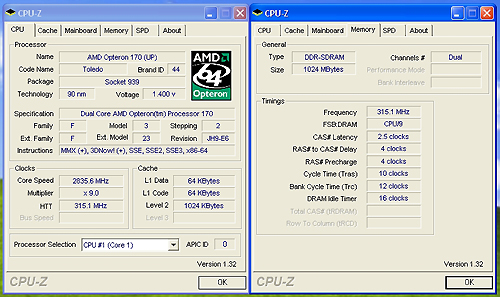ASRock 939SLI32-eSATA2: ULi Dual x16 SLI
by Gary Key on March 2, 2006 12:15 PM EST- Posted in
- Motherboards
FSB Overclocking Results
Memory Stress Testing
Memory stress tests look at the ability of the ASRock 939SLI32-eSATA2 to operate at the officially supported memory frequencies of DDR-400, at the best performing memory timings that the OCZ PC4800 Platinum Edition will support.
The ASRock 939SLI32 was extremely stable with 2 DDR modules in Dual-Channel mode at the settings of 2-2-2-5 at 2.7V. We will now install all four available memory slots that result in more strenuous requirements on the memory subsystem than testing 2 DDR modules on a motherboard.
The ASRock 939SLI32 was very stable with 4 DDR modules in Dual-Channel operation at the settings of 2-2-2-8, but required the command rate be increased to 2T that is typical in AMD Athlon 64 based systems.
| Front Side Bus Overclocking Testbed | |
| Processor: | AMD Athlon 64 4000+ (San Diego) AMD Opteron 170 (Toledo) |
| CPU Voltage: | 1.400V (1.300V default) |
| Memory Settings: | 2-2-2-5 1T - (12x) 2.5-3-3-7 1T - (10x) 2.5-4-4-10 1T - (9x) |
| Memory Voltage: | 2.8V |
| Chipset Voltage: | 2.1V |
| FSB Voltage: | 1.40V |
| HT Multiplier: | 5x up to 240HTT, 4x up to 315HTT |
| Memory: | OCZ PC4800 Platinum Edition |
| Cooling: | Thermaltake Big Typhoon |
| Power Supply: | OCZ Power Stream 520 |
| Maximum CPU OverClock (4000+): | 237HTT x 12 (2846MHz) +19% |
| Maximum HTT OverClock (4000+): | 315HTT x 9 (2835MHz) +57% |
| Maximum CPU OverClock (O170): | 270HTT x 10 (2700MHz) +35% |
| Maximum HTT OverClock (O170): | 315HTT x 9 (2835MHz) +57% |





Memory Stress Testing
Memory stress tests look at the ability of the ASRock 939SLI32-eSATA2 to operate at the officially supported memory frequencies of DDR-400, at the best performing memory timings that the OCZ PC4800 Platinum Edition will support.
| ASRock 939SLI32-eSATA2 Stable DDR-400 Timings - 2 DIMMs (2/4 slots populated - 1 Dual-Channel Bank) |
|
| Clock Speed: | 200MHz |
| CAS Latency: | 2 |
| RAS to CAS Delay: | 2 |
| RAS Precharge: | 2 |
| RAS Cycle Time: | 5 |
| Command Rate: | 1T |
| Voltage: | 2.7V |
The ASRock 939SLI32 was extremely stable with 2 DDR modules in Dual-Channel mode at the settings of 2-2-2-5 at 2.7V. We will now install all four available memory slots that result in more strenuous requirements on the memory subsystem than testing 2 DDR modules on a motherboard.
| ASRock 939SLI32-eSATA2 Stable DDR-400 Timings - 4 DIMMs (4/4 slots populated - 2 Dual-Channel Banks) |
|
| Clock Speed: | 200MHz (800FSB) |
| CAS Latency: | 2 |
| RAS to CAS Delay: | 2 |
| RAS Precharge: | 2 |
| RAS Cycle Time: | 8 |
| Command Rate: | 2T |
| Voltage: | 2.7V |
The ASRock 939SLI32 was very stable with 4 DDR modules in Dual-Channel operation at the settings of 2-2-2-8, but required the command rate be increased to 2T that is typical in AMD Athlon 64 based systems.










46 Comments
View All Comments
Gary Key - Saturday, March 4, 2006 - link
It works very well on this board with an Opteron. ;-)Kiste - Thursday, March 2, 2006 - link
In the past, Realtek has solved performance issues by reducing the number of buffers and disabling EAX effects without telling anyone. I hope someone will have a really good look at these integrated audio solutions one day, one that isn't just FPS and CPU utilization.
Gary Key - Thursday, March 2, 2006 - link
To date with the HD Codecs, Realtek has not decreased the buffers nor have we noticed changes in EAX2 output except for the positive. It is a very subjective area to comment on but in BF2 I like the sound quality of the 1.29 drivers better but Serious Sam II seems to have improved a great deal in the 1.30 and 1.31 drivers. While the on-board audio solutions are still lacking in most areas compared to the add-in solutions at least the manufacturers (board/chipset) are trying to improve quality in this area instead of pumping out the same old AC97 codecs. If it were not for the cost I think we would have seen several additional Audigy-SE solutions on the motherboards by now and even possibly an improved offering from Creative. While the A-SE is an older chipset it does offer better performance and audio quality in gaming than the current HD codecs from Realtek, C-Media, ADI, and SigmaTel. I really thought the VIA Envy24 series would have had greater market penetration on the motherboards but one can only speculate as to why this never happened. ;->
tjpark1111 - Thursday, March 2, 2006 - link
is it just me, or does this thing have a 20-pin power connector. ?!?!?!??!???kelim - Thursday, March 2, 2006 - link
Yes, the board does in fact use a 20-pin power connection. If you have a 24-pin PSU, this shouldn't be a problem, since most are 20+4-pin, meaning you can detach the extra 4 pins and only use the ones you need. Either that, or the uneeded pins will hang off the side.Gary Key - Thursday, March 2, 2006 - link
You are correct, it is a 20-pin ATC connector as stated in the article. I was surprised also and did a double take after removing it from the box. :)dab - Thursday, March 2, 2006 - link
It says that this motherboard supports ddr2,"(4) x DIMM, max. 4GB, DDR2 400/333/266, non-ECC, un-buffered memory..."
Is this a joke? There's no 240pin slots on that board, only on the riser (which is not included). s939's IMC doesn't support this either..
Am I mistaken?
Gary Key - Thursday, March 2, 2006 - link
I was just changing that to DDR, sorry about the mistake. The AM2 daughter card will have slots for DDR2 memory.
Puddleglum - Thursday, March 2, 2006 - link
The figure is noteworthy, but it's actually the only Firewire 800 test result I can find in AT's reviews.Gary Key - Thursday, March 2, 2006 - link
I know we only have it in a recent review and probably should drop it. I keep hoping Firewire 800 will be implemented on the higher end boards or those designed for HTPC life. :) However, it appears to be a dead-end option at this point and the technology itself seems to be going away without a fight.